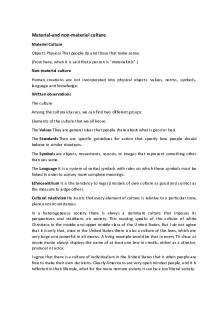EC260 - Midterm Material PDF

| Title | EC260 - Midterm Material |
|---|---|
| Author | Mackenzie cooper |
| Course | Intermediate Microeconomic Analysis for Management |
| Institution | Wilfrid Laurier University |
| Pages | 28 |
| File Size | 869.8 KB |
| File Type | |
| Total Downloads | 828 |
| Total Views | 961 |
Summary
CHAPTER 1● Managerial economics - how managerial decisions are made for a firm, given limited resources ○ Manager must understand the reactions of others to its decisions, or how their behaviour/characteristics influence the manager’s choice. ● 3 groups manager is concerned with: ○ Consumers (source...
Description
CHAPTER 1 ●
●
● ●
Managerial economics - how managerial decisions are made for a firm, given limited resources ○ Manager must understand the reactions of others to its decisions, or how their behaviour/characteristics influence the manager’s choice. 3 groups manager is concerned with: ○ Consumers (source of profit) ○ Competitors (loss of profit) ○ Government (set regulations allowing you to operate/not operate) Role of the Manager: Given limited resources, complete firm’s objective ○ Usually the objective is to maximize profit Other potential objectives (just different ways of saying to maximize profit): ○ Max. production at the lowest cost possible ○ Cost allocation (ie R&D vs advertising spending) ○ Compensation scheme for workers/employees
Profits ● Assumption: All firms/companies/corporations want to maximize profits ● Several components of profit: ○ Revenue = money coming in ○ Cost = money going out ○ Profits = revenue - costs Trade-Offs ● The most common problem for managers is trade-offs ○ It arises because of limited resources ● Increasing production increases revenue, which increases profits. ○ To increase production, inputs must increase, which also increases costs and lowers profits. ● The question becomes, how much production to trade for inputs to maximize profits? Other examples: Limited spending budget for advertising and R&D, Long-run versus short-run, increase price to increase revenue but higher price means a lower quantity sold (law of demand, supply and demand curves show trade-off problems) Other Decision Makers ● The market is an exchange mechanism that allows buyers and sellers to interact. ● Managers must understand that behaviours of the players in the market (consumers, competitors) and rules of the market (government) can influence their company.
Strategy
●
●
●
The action plan: ○ How much to produce, price to sell, etc are the company's strategy ○ The strategy must account for all possible outcomes to max. profit How to determine strategy? ○ Economics models describe a relationship between 2 or more variables. ○ For example, profit function (equation that shows the relationship of profit levels and price/quantity) Within models, there are many assumptions. They simply the model and allow economists to focus on the main issue ○ E.g. consumer preferences are homogeneous (aka similar to the average consumer, so those preferences can be multiplied to the total population)
Economics models ● Economics models only form a hypothesis, there is still a need to do actual tests ● A tested and confirmed hypothesis becomes a theory or law ○ E.g. economic intuition states that as price increases, quantity falls ● We see that this occurs in reality too ● Therefore, we have the law of demand Positive vs Normative Statements ● Positive statements - testable hypothesis, it states a cause and an effect, does not need to be true, just testable ○ “As we increase price, people will buy less” (this can be tested) ○ “A decrease in taxes will lead to an increase in spending on vacations” ● Normative statements - suggest a course of action ○ ie government should increase taxes on cigarettes so people stop smoking ○ “Unemployment is more harmful than inflation” CHAPTER 2 Demand ● Many things influence a consumer’s decisions when purchasing of goods/services ○ Ie price, quality, substitutes, income, preferences ● Quantity Demanded is the quantity of a good or service that consumers are willing to buy at a given price, all other factors held constant ○ Specific number of quantity at a price of x dollars ● The relationship between price and quantity demanded is the demand curve ○ Price on the vertical axis, quantity on the horizontal ● Curve can be drawn for one person, or for an entire economy ● It is downward sloping because as price increases, quantity decreases ○ It must be drawn inverted or marks are deducted. ● The curve can be convex or concave, perfectly vertical or perfectly horizontal, it is not always just a downward sloping straight line. Movement vs Shift
● ●
●
If quantity demanded changes due to price change, we have a movement along the curve If other factors that are NOT price affect the quantity demanded (income, preferences, etc) then we have a shift in the curve ○ E.g. if average income in an economy rises, we can expect people to want more stuff, meaning that quantity demanded increases at the same prices as before the economies rise. ○ This creates a shift outward (right) of the demand curve. Other examples: ○ Studies show health benefits of blueberries (demand curve shifts right) ○ Price of coffee falls (obviously price goes down, but if you take your coffee with sugar, the demand curve of sugar shifts right) ○ Government subsidies (demand curve shifts right)
The Demand Function ● Suppose we incorporate more than just price in the demand curve, for example income. ○ Q = D (p,Y) ○ P = price, Y = income ● When more variables are included, it is a demand function. ○ E.g. Q = 10 - 2p + 0.5Y ● If we fix Y at a specific income level (Y=20) then we get… ○ Q = 20 - 2p ➔ Does this demand function follow the Law of Demand? (2 ways to see if it does) 1. Fastest way: derivative; if change is negative then it follows the law of demand as it means the slope of the entire curve is negative. 2. Other way - take 2 points on this demand curve ●
Let’s take 2 points on this demand curve: ○ Q1 = 20 - 2p1 ○ Q2 = 20 - 2p2
●
Subtract (Q2 - Q1) Change in Q = (20 - 2p2) - (20 - 2p1) Q2 - Q1 = (20 - 2p2) - (20 - 2p1) Change in Q = -2p2 + 2p1 ΔQ = -2(p2 - p1)/ΔP
●
Suppose there was a negative change in Q (-ΔQ) ○ This means Q1 > Q2
●
The only way the equation is satisfied is if ΔP is positive or P2>P1 ○ This means as price increased, quantity decreased ○ Satisfies Law of Demand
Summing up Demand Curve Q = Q1 + Q2 Q = D1(p) + D2(p) ● ●
● ●
This is very common for demand curves on an economy An economy is composed of many individuals with potentially different demand curves, so assumptions need to be made where everyone is homogeneous or the average demand curve is taken ○ This is why some demand curves are straight despite all the differences among individuals The economic quantity demanded is the sum of all individuals in the economy. Suppose we want to draw the summed demand curve of 2 individuals…
P
Person 2 buys nothing any point above the dotted line.
Q1
Q1
+Q
2
Q2 D
Supply ● Quantity supplied is the amount of a good or service a firm is willing to supply at a certain price ○ If a product can be sold at a higher price, firms tend to want to supply more
● ●
●
P
The supply curve is the relationship between the price and the quantity supplied by a firm. Quantity supplied is influenced by price, but can also be influenced by increases or decreases in input prices, government regulations, etc (ie quotas which put a cap on how much can be supplied) Similar to demand, there is an individual or market or economy supply curve… ○ The curve is upward sloping (Law of Supply) ○ Inverted axis just like demand curve (P on vertical axis, Q on horizontal) ○ Does not have to be a straight line
Typically, Y intercept is above 0. Lowest can be 0. It infers that a firm is willing to supply 0 at a given price. Q Supply Function Suppose we incorporate the impact of input prices. Q = S(p,pc) Where pc = price of an input for production Functional form: Q = 10 + p - 0.5 pc P has a positive coefficient, so this follows the law of supply
● ●
Hold price of input constant at 10... ○ Q=5+p If the price increases then △ P>0 and △ Q>0. Summing of supply curves is the same as for demand curves.
Market Equilibrium
●
●
Equilibrium is obtained when all participants do not want to change their behaviour ○ For a market, it is when buyers and sellers want to buy and sell the same quantity. Market equilibrium is achieved when quantity demanded is EQUAL to quantity supplied. ○ This is equilibrium quantity, which is made possible by equilibrium price.
Determining Equilibrium ● Suppose we have a demand function given by: QD = 10 - p ● The supply function is: QS = -1 + 0.5p ● At equilibrium, QE = QD = QS ● 10 - p = -1 + 0.5p ● -1.5p = -11 ● p = 22/3 = 7.33 (approx.) ○ Sub p into QS or QD ● QS = QD = QE = 2.67
Use 3 decimal places when there is a multi-step question, or use ALL decimal places. ● By the “invisible hand” theoretically markets should reach equilibrium without any intervention. ● Suppose firms supply more than equilibrium quantity and sell at a higher price than equilibrium. ● Firms supply Qs and sell at P2 ● At P2, consumers will only buy Qd which leads to excess supply
●
○ Prices will fall until P1=PE If P1 is below Pe ○ There will be excess demand ○ Suppliers increase the price and increase production until P1 = Pe and Q = Qe
S P 2
Qs > Qd Firms are wanting to produce more than what is demanded
P 1
D Qd
Qs
Shocks to equilibrium ● Without any outside intervention, you should always be at equilibrium ● When an economy or market reaches equilibrium there are no incentives for either to change strategies, thus maintaining equilibrium… ● Unless an outside force provides a shock and shifts the curve ○ Anything outside of price and quantity that changes buying or selling strategy is referred to as a shock ○ E.g. Suppose average income increases. We determine this should shift the demand curve outward (right)
How do we get to a new equilibrium? 1. First demand shifts from shock, but old prices still exist 2. At old prices, there is excess demand which puts pressure on prices to rise 3. Prices increase until E1 levels 4. Equilibrium moves over time until E1
P S
E 1 E
D
D1 Q
● ●
●
If there is only one shock (either demand or supply shock), the equilibrium simply moves along the other curve that is not being shocked Multiple shocks to supply and demand can create complications though. ○ If we cannot predict the magnitude of the shifts, the change in equilibrium is unpredictable. Drawing the graphs can help you to see the exact change
Government ● Regulates the market through setting quotas, price floors, government spending, etc ● Many times governments set policies that change supply and demand like the ones above... ○ Example: Increasing age limit on smoking or alcohol ○ This decreases demand since the market size for each product decreases; there is less demand at every price point ○ The government could also restrict certain inputs which decreases supply
Price Ceilings/Floors ● Governments can also influence price by not allowing goods to he sold above/below a certain price ● Both price ceilings and floors show that an economy is not always in equilibrium
● ● ●
The government intervenes and does not allow prices to exceed Pbar (price ceiling). At low prices, consumers want to buy more and firms do not want to supply. A persistent shortage occurs in this economy. ○ Price ceilings are common for necessities like hydro.
Price floor is a form of government intervention ○ Minimum wage is the most common example ● Consider firms as the demand side looking for labour and us as the people in the market supplying it (supply curve in this example is how many hours of labour we’re willing to give at a given price, demand curve shows the amount of labour firms are seeking) ● Excess supply is created because QS = 400 but QD = 200 Sales Tax ● A type of tax that is a specific tax. ● The government collects a specific dollar amount per unit sold from the seller. ○ E.g. Suppose the government collects t per unit from the seller. ○ The firm keeps p-t (price minus tax) from each unit ● The idea that firms pass the tax burden in full to the consumers is mostly true. ●
●
● ●
However, it is more common that only partial burden is passed. ○ The previous example showed the distance t. When supply shifts, consumer went from paying E to E prime, (p to p prime) The shift from p to p prime is smaller than t This means, the taxing of the supplier t did not increase the costs to consumers of t, and the firm actually absorbed some burden.
The Price Elasticity of Demand ● If a manager chooses to change the price of a product, they will need to know how much quantity will change. ● The price elasticity of demand is the % change in quantity given a % change in price. ○ Allows you to compare different demand functions regardless of the scale of what is being dealt with. ● Price Elasticity of Demand = %ΔQ / %ΔP ● Price Elasticity of Demand = (ΔQ/Q) / (ΔP/P) Arc Price Elasticity of Demand ● Arc Price Elasticity of Demand = (ΔQ/Qbar) / (ΔP/Pbar) ● You will be asked to find initial demand, arc demand, or final demand Point Elasticity of Demand ● So far, the elasticity is evaluated by a change in quantity demanded. We can also find that elasticity at a specific point on the demand curve called point elasticity. ● This requires a demand function and derivatives (see written notes) ● Given a specific price level, p, we can find the point elasticity of demand at that point. ○ Different values of p will give you different elasticities. Income Elasticity of Demand ● If your income increases, you have more money to spend and your quantity demanded for goods is expected to increase ● ● ●
% ΔQd % ΔY Normal goods - if income goes up you buy more of these ○ Ɛi > 0 Inferior goods - if income goes up you buy less of these ○ Ɛi < 0
Cross Price Elasticity of Demand ● If the price changes on other products how does that affect Q demanded? ● Ie Price of sugar goes up, how does that impact your coffee consumption? ● ● ●
XED=
% ΔQx % ΔPy
For complements like coffee (x) and sugar (y), Ɛxy < 0 For substitutes like coffee (x) and tea (y), Ɛxy > 0
Other types of Demand Curves ● Horizontal demand curve: perfectly elastic demand ○ Consumers are willing to buy as much as they can if price is below or equal to p* ○ Potentially many substitutes (ie gasoline) ○ P* is the highest possible to make Q=0, so lowering price will increase quantity by an infinite amount since it is increasing from 0 ● Vertical demand curve: perfectly inelastic demand ○ Regardless of price, you're gonna buy q* (i.e. necessities, life-saving medicine) ○ Price is already at 0 and the %ΔQ is always 0 at a price of infinity CHAPTER 4 - CONSUMER CHOICE ●
● ●
●
Individual tastes/preferences determine what kinds of goods they will buy. Individuals will seek to maximize the level of satisfaction they can obtain, subject to their budget constraints. Consumers usually have preferred ranking of goods they can buy: ○ Ie coffee over tea, BMW over Mercedes Consumers also prefer variety in their goods. ○ This means that consumers must spend their limited budget to get the optimal bundle of goods. Understanding how consumers make decisions is important to a manager’s strategy and decision making.
Assumptions about Consumer Preferences 1) Completeness - they always have a preference between 2 goods, they would never say “I don’t know” if given the chance to choose between them. A consumer is always able to rank a bundle of goods. If there 2 bundles, E and F, a consumer can have only of the following results: a) E > F b) F > E c) E = F 2) Transitivity - If a consumer has preferences a ≥ b and if they also have preferences b ≥ c, then it must be true that a ≥ b ≥ c 3) More is Better - More of a good is always better, if you could graph a consumer’s happiness in terms of quantity, then more is always better. ● ●
How can we rank consumer goods by preferences? ○ Suppose a consumer consumes only 2 goods, x and y We can illustrate all possible combinations of quantity of x and y on a graph
Utility ● Satisfaction cannot be measured numerically (ie no unit of measure like length, weight, etc)
● ● ● ●
Economists assign numbers to a level of satisfaction to give a relative rank. This is called utility. If a bundle of goods has a higher utility number, that bundle is preferred. Utility numbers have no unit of measure.
Utility Function ● It is the relationship between the amount of goods consumed and utility level. ● Suppose an individual consumes only pizza (P) and coke (C). ● Their utility might be, U = (P*C)^(½) or U = (P*C)^2 ● Utility is an ordinal measure, meaning the number only gives a ranking. ● Suppose bundle 1 gives utility of 5 and bundle 2 gives us utility of 10. We can only conclude that bundle 2 is preferred to bundle 1. ● Cardinal measures are both ranked and can be compared (money, weight, length) Special Scenarios for Consumers: Corner Solution Sometimes a consumer is better off consuming none of the other item Indifference Curves ● Any combination of x and y on an indifference curve means the consumer is indifferent about it
● ●
● ●
Any dot above and to the right of the lower indifference curve is preferred to E and C D is preferred to bundles E and C ○ We know D must be on another indifference curve because indifference curves are parallel and do not cross ○ Any point below the indifference curve with bundles E and C is not preferred If two indifference curves did cross, “More is better” and transitivity would contradict one another (see notes for detailed explanation) Indifference curves are ALWAYS downward sloping because of the trade-off of goods
● ●
Indifference curves state that A=B, but in this case B>A This contradicts transitivity and shows why indifference curves are downward sloping
Marginal Rate of Substitution (MRS) - the trade-off between 2 goods while staying on the same indifference curve ● MRS = △Y/△X ● When someone gives up goods, it is negative (-) Why convex indifference curves? ● We assume individuals have a diminishing MRS (see notes for a graph) ● As you move down on the indifference curve, the ratio of the △Y/△X will become smaller and smaller ○ This is because the further down you are, the more of good X you will have and therefore will be willing to give up for good Y which you will not have much of
Two Extreme Indifference Curves Perfect Substitutes ● Ie Coke and Pepsi ● Straight lines with slope of -1
Perfect Complements ● “L” Shape ○ Coffee & Sugar ● Corners will be at a specific ratio ● If there is consumption of one good, the other cannot be 0 ● All other indifference curves are imperfect substitutes
Marginal Utility ● Change in utility from an increase in consumption
From the previous example, suppose the utility function is,
U = √ PC And the individual is currently consuming P = 4 and C = 5. Current utility is U = √ ( 4 )( 5) = 4.47 What is the marginal utility of pepsi?
ΔU ΔP If they consume 1 more pepsi, Δ P = 1, the new utility is. MUp=
U =√ 5 x 5
=5
The change in utility from consuming 1 more pepsi is Δ U =5− 4.47= 0.53 Marginal utility of pepsi is; ΔU 0.53 =0.53 MUp= = 1 ΔP Exercise: Repeat for Coke MUc = 0.1 The relationship between MU and MRS is...
MRS =
− ΔY ΔX
=
− ΔY ΔU
+
ΔU ΔX
=
−1 MUy
+
MUx
−MUx MUy ➔ On an exam, he will tell you where to put exactly which variable is put on what axis. MRS=
In our example, MRS=
−MUx −0.53 =−5.3 = 0.1 MUy
Budget Constraints ● Everyone has a budget constraint ● The restriction is income,...
Similar Free PDFs

EC260 - Midterm Material
- 28 Pages

COMM 225 - Midterm Review Material
- 10 Pages
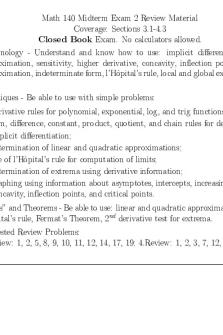
Midterm 2 review material guide
- 6 Pages
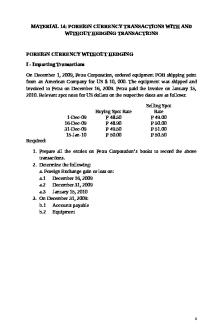
MATERIAL-
- 23 Pages
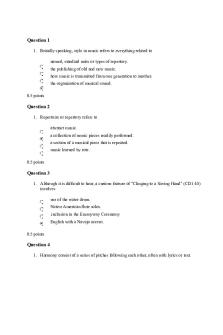
Midterm
- 25 Pages

Midterm
- 15 Pages
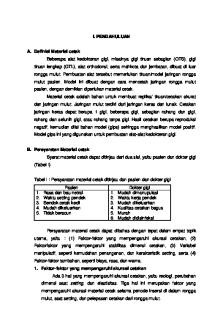
Material Cetak
- 40 Pages
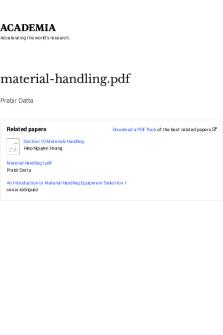
material-handling.pdf
- 245 Pages
Popular Institutions
- Tinajero National High School - Annex
- Politeknik Caltex Riau
- Yokohama City University
- SGT University
- University of Al-Qadisiyah
- Divine Word College of Vigan
- Techniek College Rotterdam
- Universidade de Santiago
- Universiti Teknologi MARA Cawangan Johor Kampus Pasir Gudang
- Poltekkes Kemenkes Yogyakarta
- Baguio City National High School
- Colegio san marcos
- preparatoria uno
- Centro de Bachillerato Tecnológico Industrial y de Servicios No. 107
- Dalian Maritime University
- Quang Trung Secondary School
- Colegio Tecnológico en Informática
- Corporación Regional de Educación Superior
- Grupo CEDVA
- Dar Al Uloom University
- Centro de Estudios Preuniversitarios de la Universidad Nacional de Ingeniería
- 上智大学
- Aakash International School, Nuna Majara
- San Felipe Neri Catholic School
- Kang Chiao International School - New Taipei City
- Misamis Occidental National High School
- Institución Educativa Escuela Normal Juan Ladrilleros
- Kolehiyo ng Pantukan
- Batanes State College
- Instituto Continental
- Sekolah Menengah Kejuruan Kesehatan Kaltara (Tarakan)
- Colegio de La Inmaculada Concepcion - Cebu







